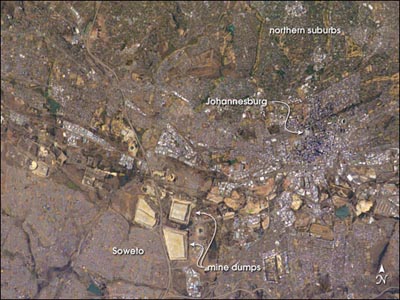
File:Joburg.iss.400pix.jpg
Joburg.iss.400pix.jpg (400 × 300 pixels, file size: 43 KB, MIME type: image/jpeg)
| |
This is a file from the Wikimedia Commons. Information from its description page there is shown below.
Commons is a freely licensed media file repository. You can help. |
| Description | This photograph of Johannesburg, South Africa, was taken from the International Space Station. The cityscape of Johannesburg is the most difficult pattern to discern. The center of Johannesburg is the fine-grained pattern (created by shadows cast from the high rise buildings in the city) in the centre of this photograph. On the southern fringe of Johannesburg is a line of light colored, angular patches stretching across the scene. These patches are the great “mine dumps” (an example is arrowed), the crushed rock that remains after gold extraction from numerous gold mines. These are the mines that underpinned the South African economy for decades, and their dumps, or tailing piles, are the visuals that orbiting crews see when they overfly Johannesburg and neighboring cities, delineating the east-west outcrop of the gold–rich rock strata discovered in 1886. Neighboring industrial cities are nestled among the mine dumps as far as the edges of the photograph. Older mine dumps nearer the Johannesburg city centre have disappeared from view in the last 25 years, having been re-mined for the gold that remained within them. The green zone (top right) is the leafy northern suburbs, where hundreds of square miles of grassland have been progressively forested since Johannesburg was founded in 1886. Small light patches within the tree-rich zone are satellite businesses and shopping centers, typical of any major western city. By contrast, a major ghetto appears as the grey zone lower left (the famous Soweto Township). Soweto appears largely treeless except for protected valley bottoms. Astronaut photograph ISS007-E-15149 was taken September 21, 2003 with a Kodak DCS760 digital camera equipped with an 400mm lens. Interpretation is provided by M. Justin Wilkinson (Lockheed Martin / Earth Observations Laboratory, Johnson Space Centre). http://earthobservatory.nasa.gov/Newsroom/NewImages/images.php3?img_id=16322 "The purpose of NASA's Earth Observatory is to provide a freely-accessible publication on the Internet where the public can obtain new satellite imagery and scientific information about our home planet. The focus is on Earth's climate and environmental change. In particular, we hope our site is useful to public media and educators. Any and all materials published on the Earth Observatory are freely available for re-publication or re-use, except where copyright is indicated. We ask that NASA's Earth Observatory be given credit for its original materials." Picture prepared for Wikipedia by Adrian Pingstone, November 2003. |
| Date | 21 September 2003 |
| Source | http://earthobservatory.nasa.gov/Newsroom/NewImages/images.php3?img_id=16322 |
| Author | NASA |
| This image or video was catalogued by one of the centers of the United States National Aeronautics and Space Administration (NASA) under Photo ID: ISS007-E-15149. This tag does not indicate the copyright status of the attached work. A normal copyright tag is still required. See Commons:Licensing for more information. |
| Public domainPublic domainfalsefalse |
 |
This file is in the public domain because it was solely created by NASA. NASA copyright policy states that "NASA material is not protected by copyright unless noted". (See Template:PD-USGov, NASA copyright policy page or JPL Image Use Policy.) |
 |
 |
Warnings:
|
File usage
The following pages on Schools Wikipedia link to this image (list may be incomplete):
More information
SOS Childrens Villages chose the best bits of Wikipedia to help you learn. In 133 nations around the world, SOS Children works to bring better education and healthcare to families in desperate need of support. There are many ways to help with SOS Children's Villages.

